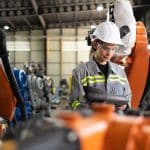In the fast-paced world of the 21st century, technology is advancing at an unprecedented rate, and with it, the means and methods of production are experiencing a seismic shift. The buzzwords on everyone’s lips in the United Kingdom’s manufacturing scene are "AI" and "automation". These words represent a radical change that is sweeping across industries worldwide. They signal a future where machines, software, and smart technology take on tasks that once required human hands and minds. This transitional phase has sparked a hot debate on whether artificial intelligence (AI) and robotic systems can improve productivity in the manufacturing sector.
The Onset of AI and Automation in the Manufacturing Industry
In the past decade, there has been an influx of AI-powered robotic systems in the UK’s manufacturing landscape. This is not without reason. Companies are constantly on the lookout for strategies and technologies that could enhance their productivity and give them a competitive edge.
A lire aussi : How Are On-Chip Optical Interconnects Improving Processing Speeds in Supercomputers?
Artificial intelligence, paired with automation, offers a tantalizing promise of increased efficiency and speed in production. By employing AI-powered robotic assistants, manufacturing companies can automate repetitive tasks, minimize human error, and increase their work pace. However, the implications of this change are far-reaching and extend beyond the mere increase in output.
AI and automation are more than tools for increasing production speed. They represent a paradigm shift in the way work is done. These technologies introduce new skills, disrupt existing job structures, and necessitate a rethinking of the human role in the workforce.
A voir aussi : What’s the Latest in Quantum Encryption for Securing Sensitive Government Communications?
The Role of AI in Boosting Productivity
At its core, AI is a technology that simulates human intelligence. It learns, adapts, and applies knowledge, thereby improving its performance over time. In a manufacturing setting, this means AI-powered robotic systems could potentially understand and optimize production processes more effectively than their human counterparts.
One clear way AI can boost productivity is through predictive maintenance. Instead of reacting to equipment failure, AI can analyze data patterns to predict when a machine is likely to fail. This allows companies to schedule maintenance proactively, reducing downtime and increasing the efficiency of the production line.
Furthermore, AI can streamline the manufacturing process by optimizing workflows. It can analyze vast amounts of data and discern patterns that humans might overlook. By interpreting this data, AI can suggest changes to the production process that could save time, reduce waste, and increase productivity.
Automation and the Future of Manufacturing Jobs
Despite the potential benefits, the integration of AI and automation in the manufacturing sector has been met with trepidation. The fear is that automation will displace human workers, leading to job losses.
According to a study by Oxford Economics, up to 20 percent of manufacturing jobs worldwide could be automated by 2030. However, this doesn’t necessarily mean that these jobs will disappear. Instead, technology could change the nature of these jobs.
The introduction of AI and automation in the manufacturing industry will likely demand new skills from the workforce. While manual tasks may be automated, there will be an increased need for employees who can manage and maintain these complex systems. This means retraining and educating the existing workforce will be crucial to ensure they can adapt to the changing job landscape.
The Challenge of Implementing AI and Automation
While AI and automation hold great potential, implementing them in the manufacturing sector is not without its challenges. For one, it requires significant investment in new systems and infrastructure. Smaller manufacturing companies may struggle to afford the upfront costs associated with AI integration.
Moreover, the transition to AI and automation requires a cultural shift within the company. Employees must be willing to embrace new technologies and adapt their skills accordingly. This requires strong leadership and a clear vision for the future of the company.
The integration of AI and automation in the manufacturing sector is not a simple plug-and-play solution. It’s a complex process that requires strategic planning, investment, and a commitment to change.
Despite these challenges, the future of manufacturing seems to be leaning towards AI and automation. As they continue to evolve, these technologies offer transformative possibilities for the manufacturing industry. The question is not if they will be integrated, but how and when. With strategic planning and thoughtful implementation, AI-powered robotic assistants hold the potential to unlock unprecedented levels of productivity in the UK’s manufacturing industry.
How AI and Automation Will Change Workforce Skills
It’s undeniable that the integration of artificial intelligence and automation will have a profound impact on the skills needed in the manufacturing industry. This change is likely to result in a decrease in the need for physical manual skills, as machines can perform repetitive tasks more efficiently and without error. However, this does not necessarily mean that employment will decline in this sector. Instead, the nature of the required skills will change.
As production processes become more automated, cognitive skills become more valuable. Employees who can manage, maintain and improve these sophisticated AI systems will be in high demand. Furthermore, social emotional skills such as leadership, adaptability and problem-solving will continue to be important as the workforce navigates the transition.
The shift towards AI and automation in the United States and around the world also has the potential to influence income inequality, as the demand for high-skilled workers may increase and the demand for low-skilled workers may decrease. This highlights the importance of education and retraining in preparing the workforce for the future of manufacturing.
Therefore, it is crucial for manufacturing companies to invest in their workforce, developing their skills to meet the needs of an automated future. This may involve training in machine learning, AI operations, and supply chain management.
Conclusion: The Future of AI and Automation in the Manufacturing Industry
The integration of artificial intelligence and automation into the manufacturing industry is more than just a passing trend; it’s a transformative shift that holds the potential to revolutionize productivity growth. While the upfront costs of AI integration may be high, the long-term benefits in terms of efficiency, speed, and accuracy could be game-changing.
However, this transition is not without its challenges. From the significant investment required in new systems and infrastructure to the necessity of upskilling the existing workforce, there is a considerable amount of work to be done. Manufacturing companies, therefore, need to approach AI and automation strategically, ensuring they are ready to embrace the change and capitalize on the benefits.
Consequentially, the future of manufacturing is not just about machines and technology. It’s also about people – their skills, adaptability, and their ability to innovate and drive change. With the right training and support, the workforce can not only adapt to the AI-powered future but also thrive in it.
In the end, the question isn’t whether AI-powered robotic assistants will define the future of manufacturing. The question is, how quickly can industries adapt and evolve to reap the benefits of this new era? The future is here, and the race is on.







